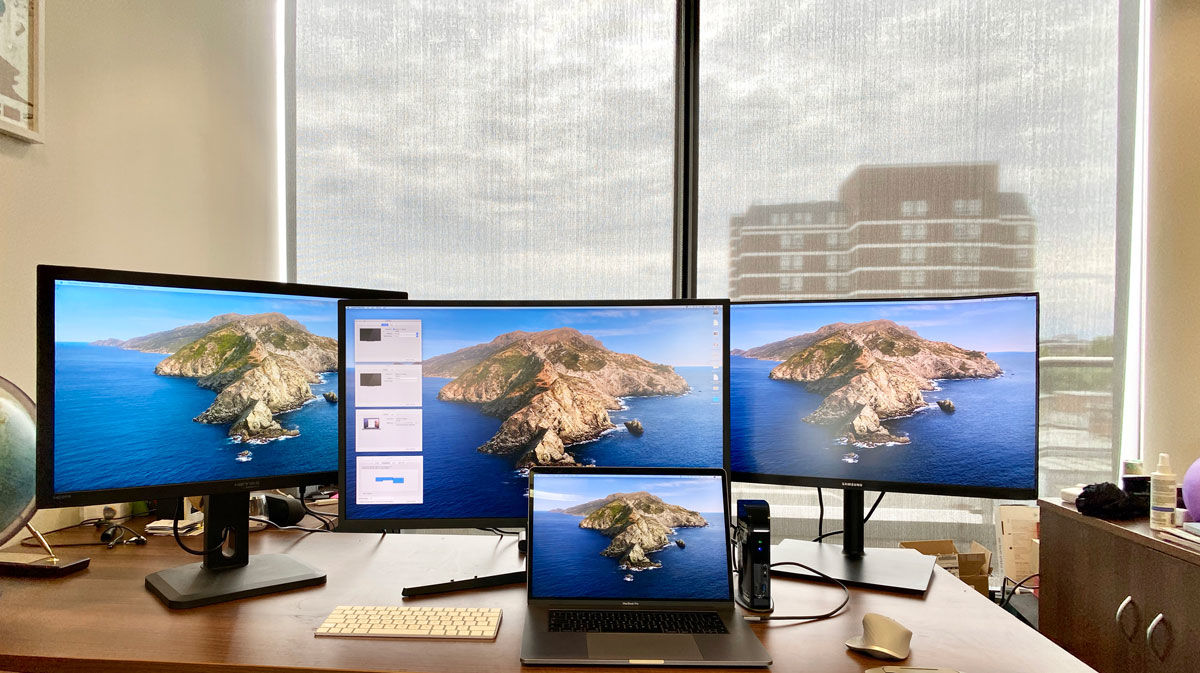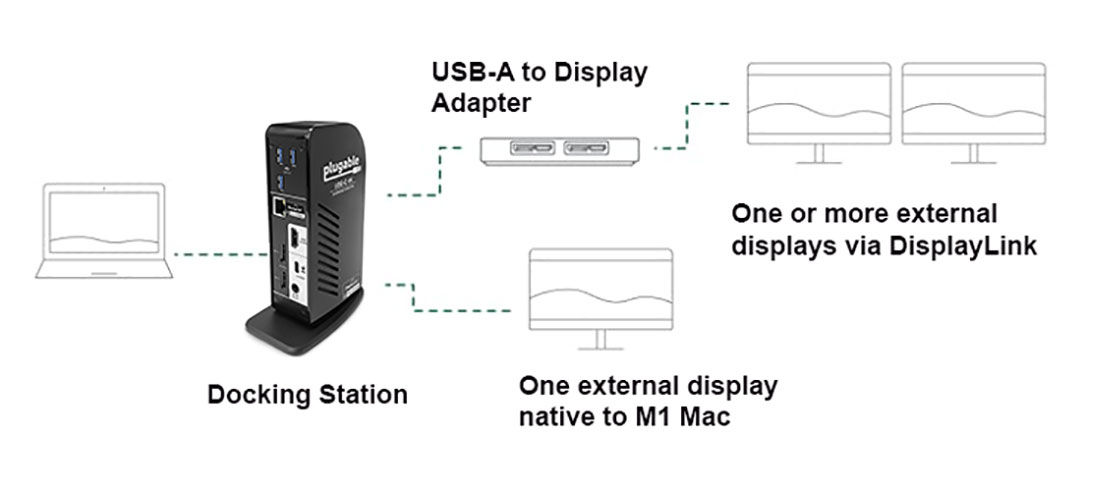Apple’s range of MacBooks that use the company’s own Silicon M1 or M2 processors cannot natively connect more than one external monitor, which is a massive limitation on the previous Intel-based generation of Mac laptops that could run two displays when connected to a USB-C or Thunderbolt 3 docking station or hub.
The M1 Pro and M1 Max do support multiple external displays. We hoped the M2 would lose the M1 limitation, but it survives on the plain M2; when available, expect the M2 Pro and M2 Max to support more displays, just like their M1 siblings.
However, there are ways around this M1/M2 limitation, allowing you to run two external displays off an M1 MacBook, which we will outline here. There’s a software driver plus hardware adapter workaround and a hub or adapter workaround.
With the software workaround, there are some risks involved as you will be required to install third-party drivers, and these might later be unsupported by future updates of the macOS. And you will likely have to buy at least one adapter, where previously a dock plus a display cable per external screen would have sufficed.
The hardware solution involves a dual-HDMI adapter that requires a little tinkering in System Preferences at setup.
If you waited for Apple’s latest 14in or 16in M1 Pro M1 Max MacBook Pro models, you are in luck as these laptops do support multiple external displays. Laptops with the M1 Pro can connect to up to two external displays with up to 6K resolution at 60Hz, while MacBooks with the M1 Max can connect to three external displays with up to 6K resolution and one external display with up to 4K resolution at 60Hz.
M1/M2 owners, start saving for a new MacBook Pro or read on.
External displays: M1 and M2 Macs’ big problem
Apple’s Mac mini, MacBook Air, and MacBook Pro 13in were the first Macs to feature the Apple-designed M1 CPU. They received rave reviews for their speed improvements over Intel-based laptops, including here on Macworld.
See our comparison of the 13in MacBook Pro (M1) vs MacBook Pro (Intel) and MacBook Air (M1 Silicon) vs MacBook Air (Intel). We have also looked at the differences between the Mac mini (M1) and Mac mini (Intel).
But if your MacBook setup includes running more than one external display, you have a major problem. Apple’s M1 or M2 chips simply won’t consider it—at least natively.
Apple states in the M1 and M2 MacBook Air and MacBook Pro tech specs that they support only “one external display with up to 6K resolution at 60Hz”.

Apple
While the M1 and M2 MacBooks natively support just one monitor, the M1 Mac Mini does natively support up to two external monitors—one via the HDMI port and a second via USB-C. But the M1 models of the MacBook Air and MacBook Pro support only one external display.
Apple has apparently promised to fix the problem in a future macOS update, but the arrival of the later M1 Pro and M1 Max—and more recently the M2—suggest that M1 owners could be waiting a long time. We have this guide to Monitors for M1 Macs and what you need to know before buying.
Workaround #1: install DisplayLink software drivers
Docking station manufacturer Plugable suggests using a combination of display technologies to get around the M1/M2 MacBooks’ single-monitor limitation. This should work with most third-party docks, although many manufacturers don’t recommend it.
Plugable’s multi-display docks use a combination of native USB-C Alternate Mode (native “Alt Mode” video output) and DisplayLink technology. This combination serves as a workaround to the M1/M2 platform supporting only a single external display via USB-C.
Note that DisplayLink requires a third-party driver to be installed on the Mac. There are different versions of the DisplayLink driver, and some bring their own compromises to the party.
And this solution still requires an extra hardware adapter.
The DisplayLink macOS app or DisplayLink Manager app are ways of enabling DisplayLink technology on macOS. The app is available as a standalone installer rather than through the mac App Store.

1. First, download the latest Mac DisplayLink driver.
DisplayLink Manager Graphics Connectivity App v. 1.1.0 is compatible with macOS Catalina 10.15, macOS 11 Big Sur and macOS 12 Monterey. It can be managed via the DisplayLink icon in the Apple Menu bar.
The macOS requires the user to permit “Screen Recording” in order for DisplayLink devices to work properly. This can be found in System Preferences under Privacy in Security & Privacy; navigate to Screen Recording in the list on the left, then tick the Screen Recording permission for DisplayLink Manager after unlocking the padlock using your admin password. You may need to quit and restart DisplayLink Manager afterwards.
More in-depth details on DisplayLink Manager under macOS Big Sur, Catalina and Monterey, in this DisplayLink support page.
Installation is straightforward, but note that this version does not support laptops’ closed-display/Clamshell mode.
Other limitations include incompatibility with display rotation. Rotation on Apple M1/M2 requires DisplayLink Manager 1.6+ with macOS 12+.
There’s an option in DisplayLink manager to “launch at startup”, or you can drag the DisplayLink Manager to your Login Items in Users & Groups.
Note that M1/M2 MacBooks can run in Clamshell Mode (meaning with the lid closed) with Displaylink attached monitors, but Intel-based MacBooks can’t and the displays will shut off when the laptop lid is closed if using DisplayLink. This won’t matter that much as Intel MacBooks can run two displays without DisplayLink, although they will need DisplayLink to add three or more monitors.

2. Then connect the MacBook to a dock, such as the Plugable UD-ULTC4K Triple Display 4K Docking Station or the Caldigit TS3 Plus dock. Learn more about the best Thunderbolt 3 docking stations for more details, or you can connect via a simpler USB-C hub.
3. For the first screen you can connect via the dock’s DisplayPort or HDMI Port, and this will be handled natively by the M1/M2 MacBook.
You could also connect the first external display via a Thunderbolt 3 or USB-C to HDMI or DisplayPort adapter.
The HDMI or DisplayPort output uses Alternate Mode (Alt Mode), and as it is basically a pipeline directly to the system’s native GPU, it will behave just like if you hooked up a USB-C to HDMI dongle to your laptop. This requires no user driver installation.
4. Additional displays cannot be handled natively by the M1 MacBook.

You need to attach the second or third display via one or more of your dock or hub’s USB-A ports, using an adapter such as StarTech.com USB 3.0 to HDMI / DVI Adapter. This costs £80 or US$80, so needs to be factored in when pricing an M1/M2 MacBook purchase if you require multiple monitors.
Another option is Plugable’s USB Dual 4K Display Adapter.
This adapter turns an available USB-A 3.0 port into one DVI-I or VGA port (DVI to VGA adapter included) and one HDMI output. Each display can simultaneously support the maximum resolution of 2048×1152 at 60Hz.
Make sure to use an active HDMI DisplayLink adapter that can support 4K at 60Hz, as some are limited to 4K at 30Hz.
DisplayLink uses an installed driver and the system CPU and GPU to convert graphics data on the system into USB data packets. That USB data is then sent over the USB cable as data packets, and converted back to video information and output to the monitors via the DisplayLink chip in the docking station.
Workaround #2: Use a special Dual HDMI adapter
Accessory maker Hyper sells two hardware solutions that allow you to add more than one display to an M1 or M2 Mac.
The Hyperdrive Dual 4K HDMI Adapter for M1 MacBook and Hyperdrive Dual 4K HDMI 10-in-1 USB-C Hub can extend to two HDMI displays: one at 4K 60Hz through HDMI and DP Alt-mode, and one at 4K 30Hz through HDMI and Silicon Motion’s InstantView technology.
Hyper says that these work “without having to download cumbersome drivers” but there is some software installation involved, and you need to allow InstantView access to your Privacy settings in System Preferences. You connect the hub or adapter to your M1 MacBook and find the HyperDisplay app that appears in a Finder folder sidebar. Double-click the macOS InstantView icon and follow the System Preferences instructions. Once this has been completed your MacBook will automatically recognise the adapter from then on.
The Dual 4K HDMI 3-in-1 USB-C Adapter ($129.99) features two HDMI ports and connects to your M1 Mac via its integrated USB-C cable. A further USB-C PD port allows you to charge the connected laptop at up to 100W—handy as the adapter itself uses up one of your M1 or M2 laptop’s two Thunderbolt ports.
A more fully fledged solution is the Dual 4K HDMI 10-in-1 USB-C Hub ($199.99), which boasts 10 ports, including the two HDMI ports and 100W PC port seen on the cheaper adapter, plus Gigabit Ethernet, 3.5mm Audio Combo Jack, SD and MicroSD UHS-I card readers, and two USB-A (5Gbps) ports. It too connects to the laptop via an integrated USB-C cable. Of the two, this multi-port hub is better value as you can use it as a dock when it’s connected to a decent USB-C PD wall charger.
Buy direct from Hyper. Shipping to the UK is currently a steep $66, so factor that in if you are not based in the US.

DisplayLink route effective but unsupported
Note that neither Plugable nor Caldigit officially supports such a DisplayLink setup for Macs. The solution works, but they warn that this could become unstuck in future versions of the macOS.
Whenever there is a new OS update the drivers may need to be updated each time.
Plugable doesn’t recommend the workaround for gaming, video editing, digital audio workstations (DAWs), and protected-content (HDCP) playback. For these workloads, users will want the full throughput of a “bare-metal” native GPU connection—such as provided by the DisplayPort or HDMI port on the dock using Alt Mode.
Caldigit actively recommends against using DisplayLink, as it finds it unreliable and there would be no synergy between the driver and the dock. Because it requires a third-party driver, users are at the mercy of Apple and the third-party developer to support later versions.
However, this combination of display technologies does allow M1 and M2 MacBooks to run more than one external monitor, and the M1 Mac mini to run more than two.
The only risk is that it could stop working at any time, although it wouldn’t harm your system if it did, and you could simply uninstall DisplayLink.
So it’s a workaround with a potentially limited timespan but the likelihood is that compatibility would be restored at some stage if the worst happened and you would get back your multi-monitor setup.
The Hyperdrive dual 4K HDMI hardware solution looks the more expensive but stable workaround of the two.
Read our M1 MacBook Air review.
If you are wanting to use a second display with your Mac and not have your Mac’s screen on, read our feature How to turn a Mac’s screen off.





